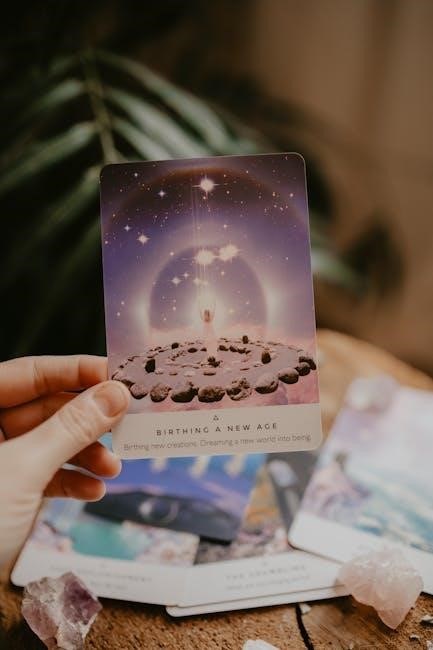
WoW Inscription is a versatile crafting profession that allows players to create glyphs, scrolls, and magical items․ It enhances spells and abilities, making it a valuable skill for customization and gameplay improvement․ Pairing it with Herbalism simplifies resource gathering, as milling herbs provides essential pigments․ This guide covers the basics, leveling, and advanced techniques to master Inscription in World of Warcraft․
1․1 What is Inscription in WoW?
In WoW, Inscription is a crafting profession that involves creating glyphs, scrolls, and other magical items․ It allows players to enhance their spells, abilities, and equipment by inscribing powerful glyphs․ Materials like herbs and pigments are used to craft these items, making it a vital skill for customization and gameplay improvement in World of Warcraft․
1․2 Importance of Inscription in WoW
In WoW, Inscription enhances gameplay by allowing players to craft glyphs and scrolls, which improve spells and abilities․ This profession is vital for customization and optimization․ Additionally, it offers a lucrative gold-making opportunity through selling glyphs on the Auction House․ Pairing Inscription with Herbalism streamlines resource gathering, making it a valuable and versatile skill for both gameplay and economy․

Training and Tools
Find an Inscription trainer in major cities to learn the profession․ Essential tools include the Virtuoso Inking Set and Light Parchment, both available from nearby vendors․
2․1 Finding an Inscription Trainer
To begin Inscription, locate a trainer in major cities like Stormwind, Orgrimmar, or Dalaran․ These trainers teach the basics and milling, enabling herb processing․ Ensure you have necessary materials like Light Parchment, available nearby, to start crafting and leveling your Inscription skill effectively from the outset․
2․2 Essential Tools for Inscription
The Virtuoso Inking Set is a must-have tool for Inscription, obtained from trainers; Light Parchment, purchased from vendors, is crucial for crafting glyphs and scrolls․ Stock up on multiple stacks to ensure a smooth leveling process․ These tools are fundamental for creating inscriptions and should always be replenished as needed․
Combining Inscription with Herbalism
Combining Inscription with Herbalism streamlines resource gathering, as milling herbs provides essential pigments for inks․ This synergy reduces costs and enhances efficiency in crafting glyphs and scrolls․
3․1 Why Pair Inscription with Herbalism?
Inscription relies on pigments obtained from milling herbs, making Herbalism a natural pairing․ This combination ensures a steady supply of materials, reduces reliance on the Auction House, and enhances crafting efficiency․ Herbalism provides the necessary resources for ink production, while Inscription offers customization options for spells and abilities, creating a synergistic relationship that benefits both professions․
3․2 Benefits of Herbalism for Inscription
Herbalism provides a steady supply of herbs for milling, which is essential for creating pigments used in Inscription․ This reduces costs and dependency on the Auction House․ Additionally, it ensures a consistent flow of materials for crafting glyphs, scrolls, and other items, making leveling Inscription more efficient and cost-effective while enhancing overall crafting potential․

Milling Herbs
Milling herbs transforms them into pigments, essential for creating inks used in Inscription․ Each herb type yields specific pigments, crucial for crafting glyphs and scrolls․
4․1 What is Milling?
Milling is a key Inscription skill that processes herbs into pigments, which are used to create inks․ This process is essential for crafting glyphs and scrolls․ Herbs are milled into pigments like Alabaster or Dusky, which vary by herb type․ Milling is learned when you train in Inscription and is crucial for progressing in the profession․ The pigments are then used to craft inks, which are vital for creating glyphs and scrolls․
4․2 Pigment Types and Their Uses
Pigments are categorized by the herbs used and their quality․ Alabaster Pigment creates Ivory Ink for basic glyphs, while Dusky Pigment makes Midnight Ink for mid-level glyphs․ Emerald and Violet Pigments produce Jadefire and Celestial Inks, respectively, for advanced glyphs․ Each pigment type is essential for specific inks and glyph crafting, progressing from basic to complex applications in Inscription․
Leveling Inscription
Leveling Inscription from 1 to 600 requires crafting glyphs, scrolls, and using milling to convert herbs into pigments․ Combining with Herbalism simplifies resource gathering․ Focus on orange recipes for skill gains and utilize First-Craft bonuses to maximize efficiency while progressing through the ranks․
5․1 Leveling from 1-75
Start by visiting an Inscription trainer to learn the profession and milling․ Mill herbs like Peacebloom to create Alabaster Pigment for Ivory Ink․ Craft items like Scroll of Stamina to gain skill points․ At level 19, make Moonglow Ink using Alabaster Pigment․ Continue crafting orange recipes like Enchanting Vellum to efficiently reach level 75․ This foundation sets you up for higher-level Inscription crafting․
5․2 Leveling from 75-200
Visit your trainer to learn Journeyman Inscription․ Use Dusky Pigment to craft Midnight Ink and Golden Pigment for Lions Ink․ Create orange Glyphs like Glyph of Stamina and Glyph of Strength to gain skill points․ Continue crafting higher-level Glyphs until you reach 200․ This phase introduces more complex recipes, requiring a mix of pigments and parchment to master intermediate Inscription techniques․
5․3 Leveling from 200-600
At 200, learn Artisan Inscription and progress by crafting higher-tier Glyphs and scrolls․ Utilize rare pigments like Azure and Ashen for advanced inks․ Discover new Glyphs through Northrend research, requiring specific materials and techniques․ Continue crafting orange recipes to maximize skill gains․ This phase introduces specialization options and intricate item creation, essential for mastering high-level Inscription․
Inscription Specializations
Inscription offers various specializations, such as Glyphs and Scrolls, each requiring specific skill points and materials․ Specializations enhance gameplay by allowing players to craft unique items tailored to their needs․
6․1 Overview of Inscription Specializations
Inscription specializations include Glyphs, Scrolls, and other magical items․ These specializations require specific skill points and materials to unlock․ Players can choose from various paths, each offering unique crafting opportunities․ Specializations enhance gameplay by enabling the creation of powerful glyphs and scrolls, which can be used to customize spells and abilities․ This system allows for deep customization and strategic play․
6․2 Choosing the Right Specialization
Choosing the right Inscription specialization depends on your playstyle and goals․ Specializations like Glyphs or Scrolls focus on enhancing spells or creating utility items․ Each requires specific skill points to unlock, with higher tiers needing more investment․ Consider market demand and class needs when selecting․ Experimenting with builds can help determine the best fit for your character and in-game objectives․

Materials and Resources
Inscription requires herbs for milling into pigments, which are used to craft glyphs and scrolls․ Light Parchment is essential for crafting․ Herbs like Cinderbloom and Stormvine are cost-effective for milling, providing necessary pigments․ Materials can be gathered or purchased from the Auction House, ensuring efficient crafting and skill progression․
7․1 Required Materials for Leveling
To level Inscription, you’ll need Light Parchment, purchased from vendors, and pigments obtained by milling herbs․ Herbs like Peacebloom and Silverleaf yield Alabaster Pigment, while others produce Dusky or Golden Pigment․ Milling five herbs typically gives two to four pigments, used to craft inks like Ivory or Midnight Ink․ Higher-level herbs provide rarer pigments for advanced inks․ Stock up on materials to ensure smooth progression through Inscription levels․
7․2 Where to Find Materials
Herbs for Inscription can be gathered in various zones across Azeroth․ Low-level herbs like Peacebloom and Silverleaf are found in starter areas, while higher-tier herbs like Nightshade appear in later zones․ Check the Auction House for affordable options or mill Herbs directly if you have Herbalism․ Light Parchment is readily available from Inscription supply vendors near trainers, ensuring you never run out of crafting essentials․

Creating Glyphs and Scrolls
Glyphs and scrolls are crafted using inks and parchment․ Glyphs enhance abilities, while scrolls provide magical effects․ Both require specific pigments and materials to create effectively․
8․1 Glyph Creation Basics
Glyph creation begins with milling herbs into pigments, which are then turned into inks․ These inks, combined with parchment, are used to craft glyphs․ Glyphs can be major or minor, enhancing spells and abilities․ The process requires specific materials and skill levels, with orange glyphs providing the best skill-up opportunities during crafting․ Proper material management ensures efficient glyph production for customization and gameplay enhancement․
8․2 Scroll Creation Basics
Scrolls are crafted using inks and parchment, providing various benefits like increased stamina, intellect, or agility; They are created by scribes and can be sold or used personally․ Different scroll types require specific inks, which are made from pigments․ The quality of the scroll depends on the inscriber’s skill level․ Focusing on orange scroll recipes ensures efficient skill point gains during the leveling process․
Maximizing Skill Points
Focusing on orange recipes and first-craft bonuses ensures efficient skill gains․ Prioritize crafting items with high skill point rewards and utilize materials effectively to optimize progression․
9․1 Efficient Crafting for Skill Points
Focus on crafting orange recipes, as they provide the highest skill point gains․ Utilize first-craft bonuses by making items when they are orange, ensuring maximum efficiency․ Prioritize materials that offer the best return on investment, avoiding green or yellow recipes until necessary․ This approach minimizes wasted resources and accelerates leveling, especially when combined with strategic material gathering and planning․
9․2 Utilizing First-Craft Bonuses
First-craft bonuses provide additional skill points when creating an item for the first time․ Prioritize crafting orange recipes to maximize these bonuses․ Focus on high-demand glyphs and scrolls, as they often yield better rewards․ Plan your crafting sequence to ensure you capture these bonuses, especially during key skill ranges․ This strategy accelerates leveling and resource efficiency․

Inscription Research and Discoveries
Inscription research unlocks new glyphs and recipes through experimentation․ Use ink and parchment to conduct research, which has a chance to discover rare or powerful glyphs․ Experiment strategically to maximize discoveries and progress․
10․1 Inscription Research Basics
Inscription research allows players to discover new glyphs and recipes by experimenting with ink and parchment․ This process requires specific materials and has a chance to fail․ Higher skill levels and rare inks improve success rates․ Researching unlocks powerful glyphs, enhancing character abilities․ Use Ink of Dreams for flexibility, as it can be traded for other inks․ Regular experimentation maximizes discovery potential․
10․2 Discovering New Glyphs
Discovering new glyphs in Inscription involves experimenting with inks and parchment through research․ Each research attempt has a 20% chance to uncover a new glyph․ Higher-quality inks, like Ink of Dreams, increase success rates․ Researching a glyph unlocks one of three possible variants, requiring multiple attempts to learn all․ This system adds depth and customization to your Inscription craft, enhancing your character’s abilities․
Making Gold with Inscription
Creating high-demand glyphs and scrolls is a profitable way to earn gold․ Monitor the Auction House for cheap materials and sell crafted items at peak times to maximize profits․ Maintain a diverse inventory to cater to different player needs and market trends․
11․1 Selling Glyphs and Scrolls
Selling glyphs and scrolls is a lucrative way to profit from Inscription․ Focus on crafting high-demand glyphs for popular specs and classes․ Use the Auction House to price competitively, ensuring quick sales․ Offer a variety of scrolls for different stats like Stamina, Intellect, and Strength․ Timing sales during peak player activity increases visibility and potential profit margins significantly․
11․2 Auction House Strategies

Maximize profits by strategically listing glyphs and scrolls on the Auction House․ Price items competitively, considering crafting costs and demand․ Post in bulk to attract buyers and reduce listing fees․ Analyze market trends to identify high-demand items․ Use addons like Auctionator for efficient pricing and tracking․ Avoid undercutting wars and focus on fair prices for consistent sales․